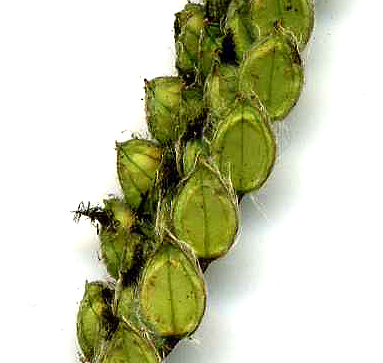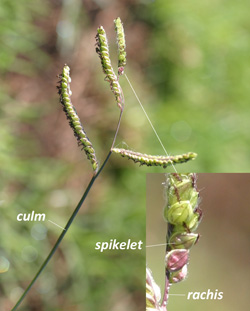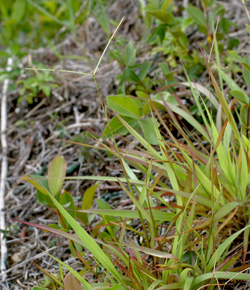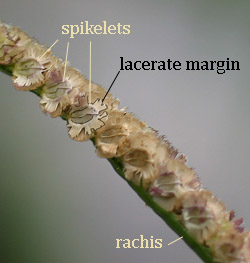|
Key to Genus Paspalum L.
|
|
 Grass plants attributable to the genus Paspalum are easily spotted in the field, having spikelets of a distinct shape. The inflorescence of a Paspalum (Figure 6B, below) comprises two or more (rarely one) racemes (branches) attached along an axis (culm) rising well above the uppermost leaf blade. Spikelets are attached by short pedicels (stalks), arranged either singly or paired, in two rows along one side (the abaxial face: facing outward or downward) of the flattened rachis. The broadly elliptic to disk-shaped (plano-convex) spikelets (Fig. 6A, right) are distinctive to Paspalum.
Grass plants attributable to the genus Paspalum are easily spotted in the field, having spikelets of a distinct shape. The inflorescence of a Paspalum (Figure 6B, below) comprises two or more (rarely one) racemes (branches) attached along an axis (culm) rising well above the uppermost leaf blade. Spikelets are attached by short pedicels (stalks), arranged either singly or paired, in two rows along one side (the abaxial face: facing outward or downward) of the flattened rachis. The broadly elliptic to disk-shaped (plano-convex) spikelets (Fig. 6A, right) are distinctive to Paspalum.
Figure 6A (right). Paspalum spikelets seen up close.
 Fourteen species of Paspalum are reported to be present in Hawai‘i (Clayton & Snow, 2010) and many are common in mesic to wet environments, including wetlands. Raulerson (2006) lists thirteeen species from Guam. All Paspalum species in Hawai‘i are naturalized species (non-native), except P. scrobiculatum (mau‘u laiki)—a southeast Asian species distributed across the Pacific Islands—is possibly indigenous or a very early Polynesian introduction. Five species of Paspalum on Guam may be native to the Marianas.
Fourteen species of Paspalum are reported to be present in Hawai‘i (Clayton & Snow, 2010) and many are common in mesic to wet environments, including wetlands. Raulerson (2006) lists thirteeen species from Guam. All Paspalum species in Hawai‘i are naturalized species (non-native), except P. scrobiculatum (mau‘u laiki)—a southeast Asian species distributed across the Pacific Islands—is possibly indigenous or a very early Polynesian introduction. Five species of Paspalum on Guam may be native to the Marianas.
Once you are comfortable recognizing an unknown grass (by spikelet shape) as a Paspalum, you can start the key at the first couplet below.
Figure 6B. The inflorescence of Dallis grass
(P. dilatatum) showing four racemes branching
off the axis. Inset is a closeup of the
discoid spikelets crowded along one side of the
rachis.
|
|
|
|
[GENUS PASPALUM] |
|
|
|
|
35a
|
|
Racemes nearly always just two in number (rarely three or more). Creeping perennials
|
|
[36]
|
|
35b
|
|
Racemes nearly always three or more per culm. Tufted (clumping) annuals or perennials
|
|
[39]
|
|
~~~~ ~~~~~~~~~~~~~~~~~~~~~~~~~
|
|
36a
|
( 31) & (35) 31) & (35) |
Plant spreading by stolons (stems growing horizontally outward and rooting at nodes). Ligule an eciliate (lacking hairs) membrane.
|
|
[37] |
|
36b
|
|
Plant spreading by underground "rootstock" (rhizomatous). Racemes 2(-3). Spikelet broadly elliptic, plump, 2.5-3.9 mm long, glabrous (without hairs); rachis broad, deep purple in color. Ligule a fringe of hairs { Small lawn grass. Bahia grass. [HAW - NAT] [GUM - NAT]
|
|
|
~~~~ ~~~~~~~~~~~~~~~~~~~~~~~~~
|
|
37a
|
(36) |
 Racemes thin to 2.5 in (10 cm) long each, widely spreading, resembling an old TV "rabbit ears" antenna. Spikelets minute, under 0.1 in (2 mm) in length. { Common small, spreading grass found in the wild and a lawn grass mostly in wet, windward areas. Hilo grass, mau‘u Hilo. [HAW - NAT] [GUM - NAT]
Racemes thin to 2.5 in (10 cm) long each, widely spreading, resembling an old TV "rabbit ears" antenna. Spikelets minute, under 0.1 in (2 mm) in length. { Common small, spreading grass found in the wild and a lawn grass mostly in wet, windward areas. Hilo grass, mau‘u Hilo. [HAW - NAT] [GUM - NAT] Paspalum conjugatum Bergius
|
|
|
37b
|
|
Racemes robust. Spikelets >0.1 in (3 to 4.5 mm) long
|
|
[38] |
|
~~~~ ~~~~~~~~~~~~~~~~~~~~~~~~~
|
|
38a
|
(37) |
Leaf blades stiff, conspicuously distichous (leaves appear two-ranked) towards upper end. Racemes erect, spreading as they mature, although infrequently flowering; most culms sterile. Culms and leaves without hairs except perhaps for a ring at the truncate, membranous ligule. { Plants growing along the margins of estuarine waters and coastal wetlands, often forming dense, dark green stands bordering the waters' edge. The inflorescence and absence of hairs distinguishes it from the similar-appearing native coastal grass, ‘aki‘aki. Seashore paspalum [HAW - NAT]
Somwhat resembles in habit (distichous leaf arrangement) and habitat, Sporobolus virginicus and Distichlis spicata.
|
|
|
38b
|
|
Leaf blades conspicuously alternate up the culm. Racemes, short erect, spikelets elliptic. Leaf sheath, ligule, and node densely hairy. { Spreading perennial in wetlands and wet soils. Knotgrass [HAW - NAT], saltgrass, knotgrass, couchgrass [GUM - IND]
|
|
|
~~~~ ~~~~~~~~~~~~~~~~~~~~~~~~~
|
|
39a
|
(33) & (35) |
 Spikelets fringed with a broad, ragged or lacerate (much cut) margin. Leaves broad, distinctly wavy; ligule a fringe of hairs. { Medium size, annual, clumping grass in mesic to wet areas; often a weed in lawns. Panama grass, fimbriate paspalum. [HAW - NAT] [GUM - NAT]
Spikelets fringed with a broad, ragged or lacerate (much cut) margin. Leaves broad, distinctly wavy; ligule a fringe of hairs. { Medium size, annual, clumping grass in mesic to wet areas; often a weed in lawns. Panama grass, fimbriate paspalum. [HAW - NAT] [GUM - NAT]Paspalum fimbriatum Kunth
Figure 6D. Close-up of spikelets of Panama grass with lacerate wing of 1st lemma of one spikelet outlined in black. Note also, prominent midnerve prolonged beyond apex of each lemma (bract).
|
|
|
39b
|
|
Spikelets fringed with hairs (ciliate or pubescent) or bare (glabrous), but lacking a surrounding ragged wing. Leaves, if broad, not wavy; ligule an eciliate membrane.
|
|
[40]
|
|
~~~~ ~~~~~~~~~~~~~~~~~~~~~~~~~
|
|
40a
|
(39) |
 Spikelets with numerous stiff hairs along margins of upper glume.
Spikelets with numerous stiff hairs along margins of upper glume.
|
|
[41] |
|
40a
|
|
Spikelets not ciliate (lacking long hairs); spikelets either smooth and hairless (glabrous) or with fine, short hairs (puberulent) or sparsely woolly along margin of glumes.
|
|
[42] |
|
~~~~ ~~~~~~~~~~~~~~~~~~~~~~~~~
|
|
41a
|
(40) |
Racemes less than 10 (typically 3 to 7). Spikelets measure more than 0.1 in (2.8 - 4 mm) in length. { Medium size, fairly common grass in wet to dry areas, sometimes a coarse weed in lawns. Dallis grass [HAW - NAT] [GUM - NAT]
|
|
|
41b
|
|
Racemes more than 10. Spikelets measure less than 0.1 in (2 - 2.8 mm) in length, typically with a purplish caste. Ligule a dense cluster of long, stiff hairs. { Medium size, coarse grass in wet areas, sometimes in or near flowing streams. Vasey grass [HAW - NAT] [GUM - NAT] [FAC]
|
|
|
~~~~ ~~~~~~~~~~~~~~~~~~~~~~~~~
|
|
42a
|
(40) |
Spikelets in pairs on each side of rachis midrib, borne on short pedicels (one slightly longer than the other), forming four rows of spikelets (NOTE: if only two rows, then pedicel evident indicating missing spikelet of each pair or rows very untidy). Glumes puberulent, sparsely woolly, or lacking hairs altogether.
|
|
[43] |
|
42b
|
|
Only one spikelet present on each side of midrib, forming two, closely imbricate rows of spikelets. Spikelets without hairs (glabrous), broadly elliptic in outline, greater than 1/16 in (2.0-2.5 mm) in length; floret light brown. Racemes widely spaced, 4 to 6 per culm, some deflexed. Leaf blades narrow, under 1/2 inch (12 mm) across, mostly without hairs (glabrous). Ligule a low membrane. { Perennial, tufted medium-size grass growing on thin, poor soils or in wetland soils. USDA noxious weed. Ricegrass, ditch millet, mau‘u laiki [HAW - ?IND], kodo [GUM - IND] Paspalum scrobiculatum L.
|
|
|
~~~~ ~~~~~~~~~~~~~~~~~~~~~~~~~
|
|
43a
|
(42) |
Racemes few, typically 1 to 10 (-15). Spikelets greater than 1/16 in (1.4 mm) long. Ligule typical Paspalum: a membrane, accompanied by long cilia across throat above ligule.
|
|
[44] |
|
43b
|
|
Racemes very numerous, ten to as many as 60, these purplish to brownish tinged and crowded on the axis. Spikelets about 1/16 in (1.3-1.4 mm) in length, suborbicular, puberulent, plump; floret pale; seed dark. Leaf collar with long white hairs { Perennial, medium size, coarse grass in wet areas. Very common across Guam. No common name in Hawai‘i [HAW - NAT] or Guam [GUM - NAT]
|
|
|
~~~~ ~~~~~~~~~~~~~~~~~~~~~~~~~
|
|
44a
|
(43) |
Racemes typically 5 to 10(-15). Spikelets puberulent or woolly on margins, nearly 1/8 in (2 to 2.7 mm) in length; floret yellow. Leaf blades mostly over 1 ft (30 cm), up to 1 in (2.5 cm) wide; culms 2-6 ft (70-200 cm) long. Ligule a tall membrane. { Perennial, medium size, coarse grass forming substantial tufts in open field in mesic locations. [HAW - NAT] Paspalum macrophyllum Kunth
|
|
|
44b
|
|
Racemes typically 1 or 2(-5). Spikelets glabrous on margins, less than 1/8 in (1.4 to 2.6 mm) in length. Leaf blades mostly well under 1 ft (30 cm) in length, up to 3/4 inch (2 cm) wide; culms 1-3 ft (30-90 cm) long. Ligule a short membrane. { Perennial, medium size grass. [HAW - NAT] [GUM - NAT]
|
|
|
|
|
|
Species of Paspalum reported to be in Hawai‘i or Guam
but not covered in this key; and some synonyms:
P. commersonii Lam. (=P. scrobiculatum)
P. cartilagineum (=P. scrobiculatum [GUM])
P. longifolium Roxb.
P. malacophyllum Trin. [HAW]
P. orbiculare G. Forst. (=P. scrobiculatum)
P. virgatum L. [HAW]
|
|
|
|
|
|
|
|
© 2012-24 AECOS, Inc. [FILE: GrassKey_Paspalum.html]
|

|
Genus Paspalum – Page 6
|
|